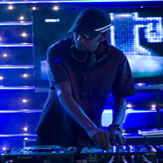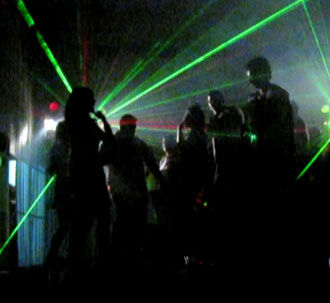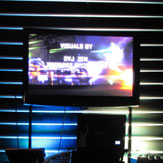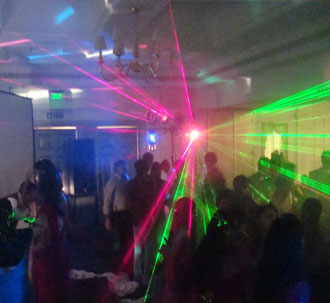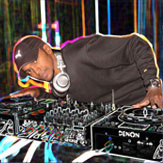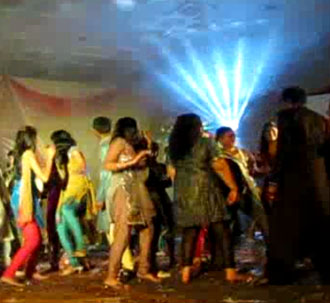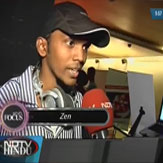
-
With over 7 years in the business
about us.
Dj Zen is one of Chennai's prolific commercial DJ's in the corporate and private event sector... -
services.
We handle all kinds of events that involves music & lights,from a small birthday party to a mega concert. What's fun without Music & Dance... -
We believe we have a unique blend of technical n entertaining skills. Our team has been carefully selected to ensure we can offer services of the highest quality with a high level of experience to back it up...
why us? -
The technicalities and the fun stuff behind the Console.If you wonder what exactly the Dj's do, this section is meant for you...
tips&tricks.
Mixing

Learning to mix music is the main task of a DJ. After much contemplation and practice, we can make the following observations.
Mixing two pieces of music involves five phases: beatmatching, starting the track, introducing the new track, phazing the two tracks and outroing the old track. With each mix of a track, the DJ must follow a set of steps to complete the mix.
-
Beatmatching is one of the toughest tasks a new DJ must learn. In order for the musical set to sound coherent, the beats of the outgoing track and the incoming track must be the same. This helps the music flow from one track to another in a natural fashion so that there is little interruption. Conceivably this could be an automated process. If a computer knew the exact BPMs of the outgoing track, it could adjust the BPMS of the incoming track to match. This involves listening to the beats of a track, each signified by a peak in the lower frequencies of music (created by the constant bass drum).
-
Starting a new track is often done incorrectly by amateur DJs. The most common mistake occurs when a DJ successfully gets the incoming track running at the same tempo as the outgoing track (in terms of BPMs) but fails to align the downbeats. It is very important to have the downbeats of both the incoming and outgoing tracks fall on the same time unit. Starting a track is different from introducing it in that the audience may not hear a track being started, whereas they will hear when it is introduced. Thus starting a track can be done 'behind the scenes' prior to introducing the track. Most DJs will start their incoming track and then introduce it into the outgoing track after the first loop has passed. Other DJs will set the tempo and start a new track without hiding the initial start of the track from the audience. When this occurs, starting the track and introducing it are done at the same time. To do this, the DJ must have previously adjusted the BPMs (or be very fast at adjusting them) and must know exactly how much of a push the incoming track may need to be brought up to the correct speed with minimal time. On some turntables, starting a record involves pushing it ahead a little as the motor accelerates up to the proper speed. On CD Players, starting is often more instantaneous and is controlled with the push of a button. It should also be noted that a track does not have to start at the very beginning of the actual song. If the DJ chooses, they can cue up the track at a differnt point if they want to play a certain portion. Tracks also do not have to be started on a downbeat but they still must have their downbeats lined up. If an incoming track is cued to start on the third beat of a loop, then it should be started on the third beat of the outgoing track's current loop.
-
Introducing a track occurs when the audience first hears the new incoming track in the mix. Prior to this, the DJ could have been cuing up the track to the desired starting point. There are three main ways to introduce a new track. The introduction can be a straight cut, where the music shifts abruptly from one track to another. It could be a half cut, where the incoming track snaps into the mix and plays with at the same volume as the outgoing track. It could also be a fade, where the incoming track fades into the mix. Different DJs like different styles and the type of track being played is also suited to different types of introductions. It should be noted that in modern dance music, most changes within a track occur on a downbeat. Thus the obvious time to introduce a new track (thus changing the musical mix) is on a downbeat. Mixes often sound more coherent if the audience hears the new track introduced on a downbeat. If done properly, they may interpret this as only a change in the current track without realizing that a new track is being played.
-
Phazing two tracks is the heart of musical mixing. This occurs when two tracks are being played simultanously as if they were one track. To phaze two records and make it sound coherent, the melodies of each track must make harmonious sense. A common rule of thumb is to never mix two vocals portions with each other as it causes two distinct streams in which the audience must follow and does not allow for unification within the music. Beats must remain in line so slight variations in BPMs must be adjusted to make sure that the phazing portion is going smoothly. Expert DJs will be able to phaze two tracks for their entire length. Amateur DJs will only be able to phaze for a short while and will opt to fade one track out quickly to insure that a there is no incoherent beatmatching occuring in the mix (resulting in a "train wreck"). While phazing, the DJ can adjust the equalizers for each track thus accenting various instruments within each track. The DJ can also cut back and forth between the two tracks to create a new beat or melody. Generally, phazing is considered the funnest part of DJing because this is where the DJ gets to use their creativity and talent to produce new pieces of music and to accent the tracks. There are many tricks on how to use different parts of a track to produce different effects such as building up the energy in a song or mellowing it down by removing the drums. New breakbeats can be created by cutting the different drum loops in each song back and forth.
-
Outroing a track involves moving the mix completely over to the previous incoming track and removing the outgoing track from the setup. This can be done by fading the old track out, cutting it off or waiting for it to finish. Some DJs' can perform tricks on the outro as well, such as stopping the track abruptly causing as screeching sound. Another popular trick when outroing records is to cut the power to turntable so that the record slowly comes to a halt. Backspins, spinning the record backwards in a quick spurt, can be effective for outroing too.
To illustrate these concepts, let's look at a mixing scenario. We will use the traditional turntable as our input device. First we play a record. Let's call it record1 and let it consist of 13 32-beat loops. That means that one loop consists of 32 beats and there are 13 of them in the song. Each 32-beat loop is broken down into 8 sub sections (displayed below in different colours) and we can count each beat as follows:
ONE two three four
TWO two three four
THREE two three four
FOUR two three four
FIVE two three four
SIX two three four
SEVEN two three four
EIGHT two three four
Record1 is a standard dance song that consists of an intro, a middle and an end (or outro). The intro is rather boring and consists of a bass drum that occurs on each beat (32 bass drums per loop) and a bass guitar that plays a tune. It plays for 2 loops. The outro is even more boring as it has the same bass drum on each beat and a hi-hat on the off beat (occuring exactly in the middle of two successive beats. The outro is 1 loop long. On the downbeat (labeled ONE) of the entire track there is a crash symbol sound. Thus we hear the crash symbol once every 32 beats. The middle is 10 loops long and contains the "meat" of the track. Here we hear guitars, pianos and trumpets. As with all dance music, each new instrument begins and ceases to play on a downbeat. The song is 120 BPMs and there are a total of 416 (= 13 * 32) beats in the song.
Record2 is another standard dance song that has an intro, a middle and an outro. It has 18 loops and in this case, each loop is 16 beats long. The intro and outro are both 2 loops long and consist of the bass drum (occuring on each beat) and some congas and bongos that play between and on beats. The middle of the this track consists of a energitic female vocalist singing in full stream. Record2 is 122 BPMs and there are 288 (= 18 * 16) beats in the song.
We have heard both tracks before and know when the middle part of the record1 ends. It is at this time that we want to start playing record2 so that the 32 beats of outro on record1 will line up with the 2 sets of 16 beats on the intro of record2. The plan is to make the middle portion of record2 begin just as record1 finishes. Thus we want to start record2 on the downbeat (labelled ONE) of the last loop in record1.
We begin with record1 starting on its first loop and playing through. We select record2 and place it on the turntable. We can cue it up by listening to record2 in the left side of our headphones. Our right ear is listening to the speakers playing toward the audience while our left ear is listening into our headphones. We cue up record2 so that the very first beat is directly under our needle. On the 33rd beat of record1 (the downbeat of the second loop), we release record2 and set it in playing mode. We are not actually introducing it now, but rather setting up its BPMs to match record1's BPMs. As the beats of the two records play, we can tell that record2's bass drum is occuring a little before record1's bass drum. We apply a slight amount of pressure on record2 to slow it down with one hand and adjust the pitch controller so that the rotation of the record is slower with the other hand. The more we slow down the pitch controller, the less pressure we have to apply to record2. While continuing to listen we find that record2's bass drum is now occuring just after the bass drum of record1. We have slowed record2 down too much and need to adjust the pitch controller while pushing the record ahead just a little to compenstate for the difference. After 16 beats have gone by from record1, we have decided that we now have record2 at the correct BPM setting (120 BPMs). We can start record2 off from the beginning again to test and make sure. We cue it up to start on its first beat and set it in play mode at the beginning of the third loop in record1 (the 65th beat). The two records ride nicely together and the beats seem to be in synchronization. Let's introduce a little of record2 to the audience. We snap the cross fader into the middle position on the 81st beat of record1 while record2 is on its 17th beat (the beginning of the second loop for record2). This is the middle of the 3rd loop on count FIVE for record1. Note that we did not introduce the track on a downbeat. But we are still following the rules of 4/4 time because we are introducing a new element in the music at a multiple of 4. Essentially, we have cut the 32 beat loop in record1 in half by introducing a new element in the middle of a loop. Now our mix consists of a piano, a trumpet a guitar and some conga and bongo drums (along with the bass drum). We let this mix ride for 16 beats and then fade it back to record1 so as not to let the melodies of the middle section in record2 interfer with an opposing melody that is occuring in record1.
Now the audience has had a taste of the second record and may think that the new conga and bongo drums are part of record1. We can inject them a few more times into the mix but recueing record2 and mixing the first 2 loops into record1. Finally, when the middle section of record1 is about to end, we can start record2 off on the first downbeat of the next loop in record1. This time we will let record2 ride all the way through without fading it out. Our mix now consists of a bass drum, some conga and bongos and a hi-hat. After 2 loops (and 32 beats) in record2, record1 comes to and end and record2's middle section begins. The audience is used to the conga and bongo drums by now and so there is coherence in the mix. Upon record1's finish, the exciting vocal of record2 begins and the audience does not miss record1 as they are now enticed by the new elements brought into the mix by record2. We can now remove record1 from the turntable and select a new track to mix into our set.
Mixing is the heart of DJing and is one of the funnest parts of being a DJ. It should be noted that most musical changes in tracks occur on downbeats and so when mixing, a DJ should follow the same method and also inflict changes on a downbeat. This makes the mix consistent with the format of the music and again, leads to coherence. On the other hand, new and creative mehtods for mixing music can be found by not following some of these rules and trying new and unique ways of intertwining tracks. As this is a relativly new form of creating music, there are no hard set rules, only suggestions based on what has worked well in the past.




